14 Day Detox for Designers:
The Ultimate Weight Loss Guide for Your Ego
14 Day Detox for Designers:
The Ultimate Weight Loss Guide for Your Ego
The Ultimate Weight Loss Guide for Your Ego
Erica Silver
→BFA GD 2020
Introduction
The first thing that I learned as an enthusiastic, ready-to-save-the-world design student was the difference between an artist and a designer. My professors repeated many times that it lies in the presence of the audience, that an artist can create work for themselves but a designer cannot create work without the audience. The audience is not just a set of eyes that witnesses the end but a fundamental part of the work itself, because they are both the subject and the object. Their reaction and response—expected or unexpected—is what defines the work. This is so crucial that we now go as far as to create audiences with imaginary people, personas, with little faces and ethnically ambiguous names. The ultimate goal here is to find everything about the audience: what they want, what they need, and what they expect. So what happens to designers when the audience suddenly disappears? What if, only a big IF, the audience cannot exist due to a global pandemic crisis that forces everyone out of school and their places of work? What if the audience doesn’t want, need, or expect anything from us? What if our creative input is the last thing on their mind?1
I can’t treat this pandemic as an opportunity to “explore the digital realm” or to find “radical creativity” as the school’s heart-wrenchingly inspiring email blasts suggest. Celebrities singing “Imagine” have done enough damage and the last thing we need is another hashtag or TikTok challenge. Designers’ constant production of disposable work is not going to save the world, either. In fact, the perpetual circulation of Design Thinking solutions is irresponsible, and does nothing but prove designers’ incurable self-importance. If revolutionary leader is an oxymoron because the leader isn’t important in a revolution2, design solution is also an oxymoron because the design isn’t important in a solution. But the industry’s obsession with innovation3 has taught designers to be clever all the time and now we don’t know when to shut up. Why can’t solitude and silence be a solution for once? I can’t seem to motivate or even to justify my creativity, and it’s an identity crisis: what should a designer, who has been taught to create work for the audience, do when the audience wants to be left alone? Do I suddenly become an artist for myself or do I stay a designer with imaginary
My questions may seem overly critical or outdated because we no longer use the word audience. It’s been replaced with other terms like the public, market, consumers, customers, users, clients, or patrons, and we are now required to approach them with a specific motive. A designer can choose (1) to criticize the public, (2) to influence the market, (3) to encourage consumers, or (4) to please clients. Hierarchy replaced neutrality, and the project is done before it even begins. The audience is no longer important but fulfilling the motive is, and the designers are expected to sell their product, not their service. This categorization of the audience has also created an unspoken class system within the design community. Designers who design for the public or the market—creating signs, tags, documents, labels, or back of the cereal box—are now considered laborers, while those who design for their patrons or fellow designers are considered Real Designers. Calling all designers “petite bourgeoisie”4 is now inaccurate because we have clearly established that the people who design to pay the bills are not the same as the people who Design with a capital D.5
As a student pursuing a degree in design at a private art school, I am culpable in this culture that I'm criticizing more than anyone else. I’m responsible for further enabling the idea that the qualification of a designer is obtained through a financial transaction, and that there is a difference in designer’s worth depending on where that transaction has taken place. I realized that this idea, endorsed and promoted by design education, undermines the definition of a designer that it’s teaching, as it leaves the audience out of the equation. I secretly hope that there’s a parallel universe where professors and lecturers don’t start their sentence with when I was at Yale School of Art or when I was working at IBM because it’s not only irrelevant but emphasizes the lack of audience in the system: designers designing for designers, or designers teaching designers who later become designers who teach designers that teach…you get the idea. This emphasis on laborers vs. Real Designers looks almost like overcompensation for the design industry’s close ties to capitalism. We chose to divide ourselves before choosing ethical design, to preserve our ego.
I realize that I’m criticizing the thing I love most—the design community. But Mr. Baldwin told me that I get the right to do so for that very reason.6 So consider this writing and the following guide a proposal. I propose that we do a “detox.” I propose that we re-learn the existing definition before innovation. I propose that we stop the ego-filled making-for-the-sake-of-making, echo-chamber-concert, and overcompensation-turned-cannibalism, because I truly believe that design is more than that.
1Dazed. “My Degree Show Was Cancelled – What Can I Do Instead? The White Pube Advise,” March 25, 2020. https:/www.dazeddigital.com/art-photography/article/48487/1/my-degree-show-was-cancelled-what-can-i-do-instead-the-white-pube-advise?fbclid=IwAR2ew5fWzNerDRT2nGT0L5XTt9rv5fB4nn7WTrYEdVzNAAQZgQD4M6U7_BI.
2Danielle Aubert, “In the 1970s, The Detroit Printing Co-Op Showed the Revolutionary Potential of Design,” Eye on Design, February 11, 2020, eyeondesign.aiga.org/in-the-1970s-the-detroit-printing-co-op-showed-the-revolutionary-potential-of-design/.
3Bierut, Michael. “Innovation Is the New Black.” Essay. In 79 Short Essays on Design, 217–19. New York: Princeton Architectural Press, 2007.
4Guy Julier, “Designers As 'Cultural Intermediaries',” in The Culture of Design (Los Angeles, CA: SAGE Publications, 2013), pp. 54-55.
5Pilar Viladas, “Design With a Capital D,” The New York Times Magazine (The New York Times, April 18, 2004),
www.nytimes.com/2004/04/18/magazine/design-with-a-capital-d.html.
6Baldwin, James. “I love America more than any other country in the world and, exactly for this reason, I insist on the right to criticize her perpetually.”
Guide
- The appendix is equally, if not more, important than the guide itself. However, I recommend reading them after each day to prevent influence over your response.
- The resources in the appendix are not a direct reference. They do not provide answers.
- The resources in the appendix are not a direct representation of my personal opinion. I may or may not agree with the authors.
Day 1
Notice the labor design around you: labels, tags, or back of the cereal box.
Day 2
Notice the unclaimed design around you: notes, graffiti, or signs at a rally.
Day 3
Write down 5 things that design can never fix.
Day 4
Write down 5 things that design refuses to fix.
Day 5
Make something without your usual tools. No Sketch, Rhino3D, or Adobe Creative Cloud.
Day 6
Make something but do not post it anywhere. Not on Instagram, Behance, or your personal website.
Day 7
Make something by following someone’s instruction. Give up control.
Day 8
Make something but credit it as unknown designer. Give up ownership.
Day 9
Offer your tools to others. Share resources.
Day 10
Invite others to modify your work. Share authorship.
Day 11
Redirect your audience to someone else. Share recognition.
Day 12
Dig out the very first design you have ever made.
Day 13
Imagine the very last design you’ll ever make.
Day 14
Do nothing (or read Jenny Odell’s How to Do Nothing).
Appendix
Day 1
 Nutrition fact labels in my pantry; a growing archive. Screenshotted on April 6, 2020.
Nutrition fact labels in my pantry; a growing archive. Screenshotted on April 6, 2020.Aubert, Danielle. The Detroit Printing Co-Op: the Politics of the Joy of Printing. Los Angeles, CA: Inventory Press, 2019.
Brown, J. Dakota. “Typography, Automation, and the Division of Labor: A Brief History.” OtherForms, November 27, 2019. otherforms.net/typography-automation-and-the-division-of-labor-a-brief-history/.
Garrison, Mark. “Ever Wonder Who Makes Those Big Highway Signs?” Marketplace, April 29, 2019. www.marketplace.org/2015/09/22/ever-wonder-who-makes-those-big-highway-signs/.
Graphic Means: A History of Graphic Design Production. Directed by Briar Levit. USA, 2017.
Plescher, Matt. “High and Low Art.” The Rapidian. Grand Rapids Community Media Center, October 3, 2013. www.therapidian.org/high-and-low-art.
Day 2
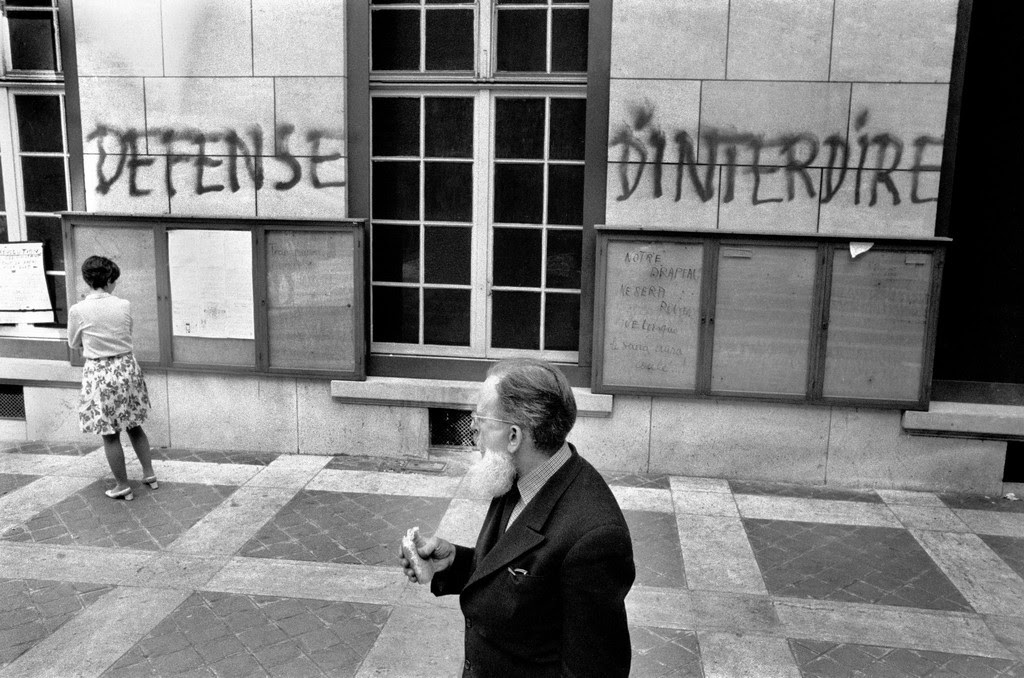 Barbey, Bruno. FRANCE. Paris. May 68. Forbidden to Forbid. 1968. Magnum Photos, New York City.
Barbey, Bruno. FRANCE. Paris. May 68. Forbidden to Forbid. 1968. Magnum Photos, New York City.France-Amérique. “May '68: All Power to the Slogans!” France, April 26, 2018. france-amerique.com/en/may-68-all-power-to-the-slogans/
“Free Printable Coronavirus Signage.” Signs.com. Accessed May 19, 2020.
www.signs.com/coronavirus-signage/.
Waldner, Lisa K., and Betty A. Dobratz. “Graffiti as a Form of Contentious Political Participation.” Sociology Compass 7, no. 5 (2013): 377–89. doi.org/10.1111/soc4.12036.
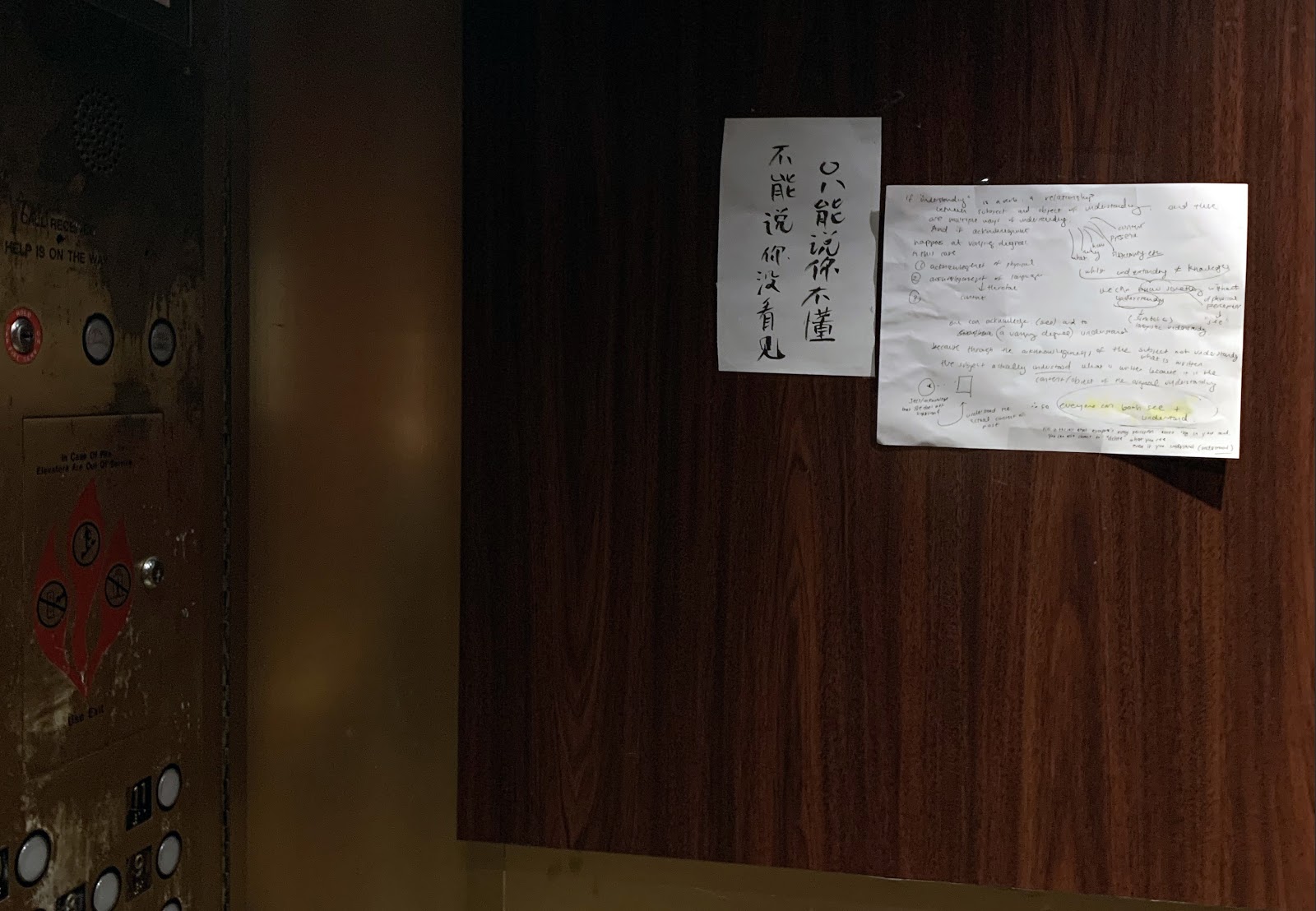 A discourse on the concept of “understanding” found on an elevator; the second note (right) appeared a week after the first one. Photo taken on May 11, 2020.
A discourse on the concept of “understanding” found on an elevator; the second note (right) appeared a week after the first one. Photo taken on May 11, 2020.Day 3
Murray, Christine. “‘Design Can't Solve All Our Problems, so Stop Pretending It Can.’” Dezeen, July 5, 2019. www.dezeen.com/2019/07/02/design-cant-solve-problems-christine-murray/.
Rock, Michael. “Fuck Content.” 2x4, 2009. 2x4.org/ideas/2009/fuck-content/.
Tighe, Colleen. “Design Is Not Neutral.” The Baffler, January 8, 2019. thebaffler.com/odds-and-ends/design-is-not-neutral-tighe.
Weaver, Jesse. “Design Won't Save the World.” Medium, August 15, 2018. medium.com/@hairyelefante/design-is-not-going-to-save-the-world-8985870471a5.
Day 4
Chen, Alex. “Design for Accessibility: Steps Toward Radical Disability Justice.” Lecture at the Better World by Design, Providence, RI. September 2019.
Bolt, Laura. “Women Make Up Over Half the Design Industry–So Why Are There So Few at the Top?” Eye on Design, March 30, 2020. eyeondesign.aiga.org/women-make-up-more-than-half-of-the-design-industry-but-how-do-they-get-to-the-top/.
Buzon, Darin. “Design Thinking Is a Rebrand for White Supremacy.” Medium, April 29, 2020. medium.com/@dabuzon/design-thinking-is-a-rebrand-for-white-supremacy-b3d31aa55831.
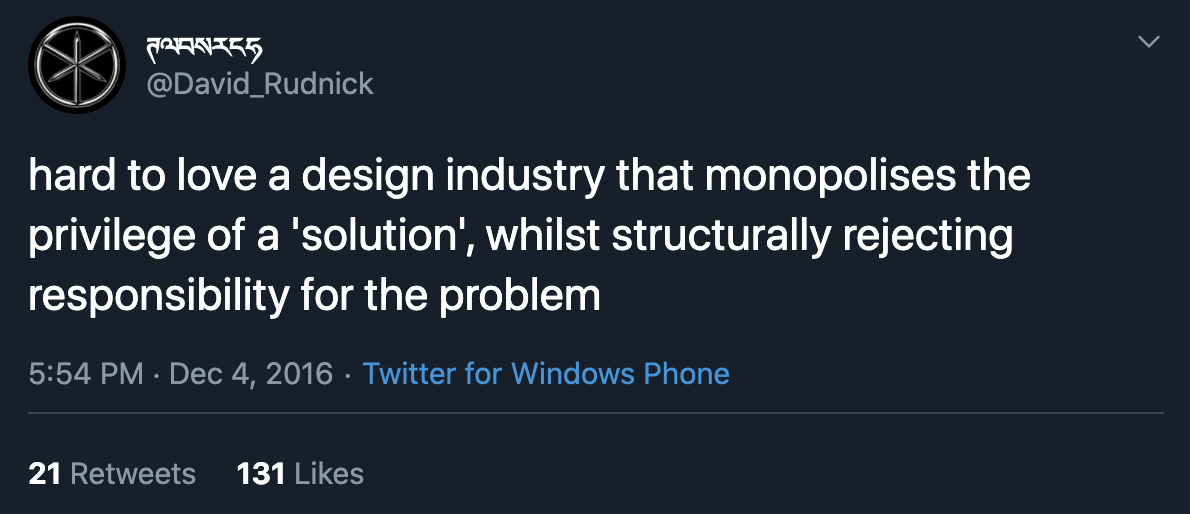 Rudnick, David. Twitter Post. December 4, 2016, 5:54 PM.twitter.com/David_Rudnick/status/805545951368617984.
Rudnick, David. Twitter Post. December 4, 2016, 5:54 PM.twitter.com/David_Rudnick/status/805545951368617984.
White, Erin. “Trans-Inclusive Design.” A List Apart, May 9, 2019. https://alistapart.com/article/trans-inclusive-design/.
Day 5
 Jobson, Christopher. “Meet Tatsuo Horiuchi, the 77-Year-Old Artist Who 'Paints' Japanese Landscapes With Excel.” Colossal, December 4, 2017. www.thisiscolossal.com/2017/12/tatsuo-horiuchi-excel-artist/.
Jobson, Christopher. “Meet Tatsuo Horiuchi, the 77-Year-Old Artist Who 'Paints' Japanese Landscapes With Excel.” Colossal, December 4, 2017. www.thisiscolossal.com/2017/12/tatsuo-horiuchi-excel-artist/.Lee, Dami. “Adobe Is Cutting off Users in Venezuela Due to US Sanctions.” The Verge. The Verge, October 8, 2019. www.theverge.com/2019/10/7/20904030/adobe-venezuela-photoshop-behance-us-sanctions.
Macharyas, Jeff. “Expensive Tools Aren't the Only Option for Graphic Design (and Never Were).” Opensource.com. Red Hat Inc., August 1, 2016. https://opensource.com/life/16/8/open-source-alternatives-graphic-design.
Ong, Jyni. “Anja Kaiser Challenges the Design Industry's Neoliberal Working Conditions to Shake up the Status Quo.” It's Nice That. Bureau for Visual Affairs, April 16, 2020. www.itsnicethat.com/articles/anja-kaiser-undisciplined-toolkit-graphic-design-160420.
Pipkin, Everest. “Open Source, Experimental, and Tiny Tools Roundup.” Google Docs. Google, February 19, 2020. everest-pipkin.com/teaching/tools.html.
 This guide was made in Google Docs as my continuing effort to combat Adobesession. Started on May 13, 2019.
This guide was made in Google Docs as my continuing effort to combat Adobesession. Started on May 13, 2019.Day 6
Dullaart, Constant. “Balconism: A Manifesto.” Art Papers, April 2014. www.artpapers.org/balconism/.
Fred, Nicolaus. “Instagram Is Phasing out Likes. Should Designers Care?” Business of Home, November 15, 2019. businessofhome.com/articles/instagram-is-phasing-out-likes-should-designers-care.
Cloyd, Allison. “If It Doesn't Exist on the Internet, It Doesn't Exist.” Elective Affinities Conference, University of Pennsylvania, September 2005. writing.upenn.edu/epc/authors/goldsmith/if_it_doesnt_exist.html.
Ho, Karen K. “If an Asian American Author Doesn't Have a Wikipedia Page, Do They Exist?” The Outline, May 16, 2018. theoutline.com/post/4560/asian-american-writers-wikipedia-edit-a-thon-kundiman-aaww?zd=1.
Wall, Kim. “The Weekly Package: How Cubans Deliver Culture without Internet.” Harper's Magazine, July 2017. harpers.org/archive/2017/07/the-weekly-package/.
Day 7
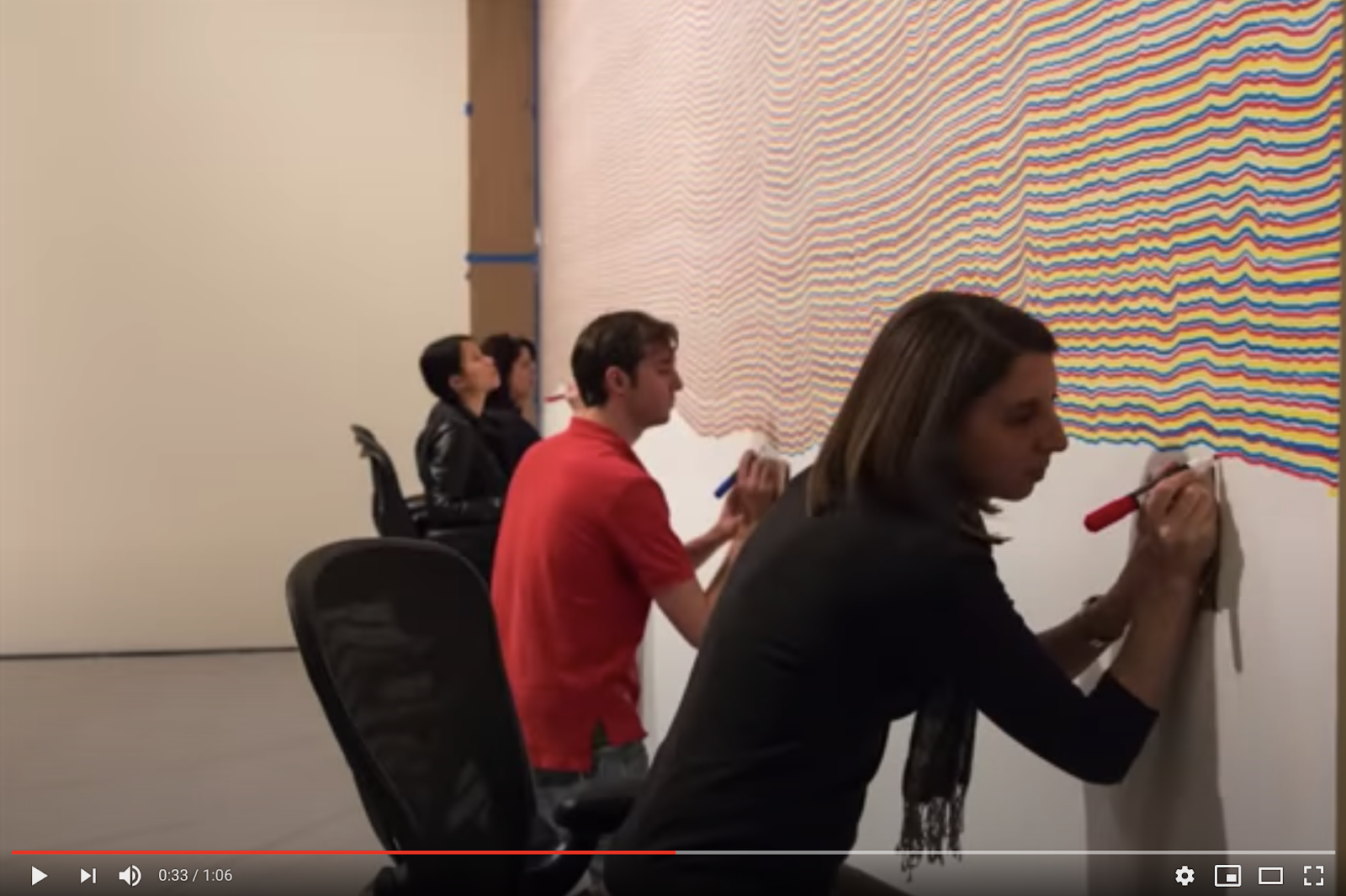
Blanton Museum of Art. “Time Lapse of Sol LeWitt's ‘Wall Drawing #797." YouTube video, 1:06. July 8, 2014. www.youtube.com/watch?v=Gc-c-pYGCrw.
Inside Edition. “Woman Gets People to Smile with Silly Sign.” YouTube video, 1:20. April 29, 2020. www.youtube.com/watch?v=tjOUwEyImuU.
Lynam, Ian. Start Somewhere: A Handbook Of Dubious Exercises, Tips And Rants About Becoming A Designer Who Writes. Tokyo: Wordshape, 2016.
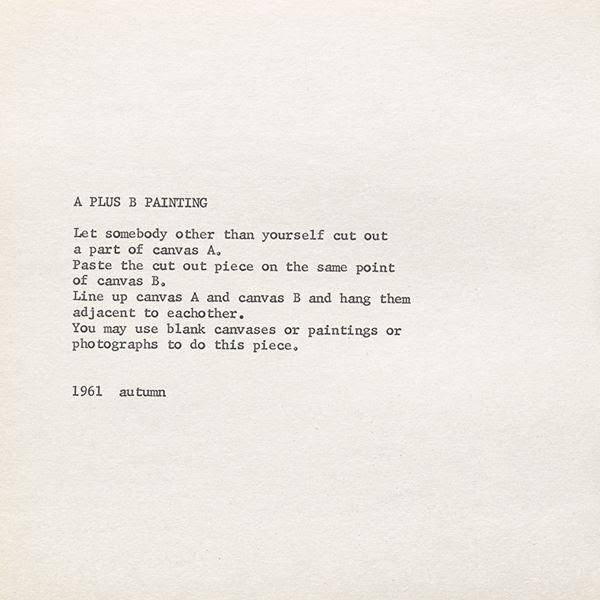 Ono Yoko. Grapefruit: A Book of Instructions and Drawings. New York, NY: Simon & Schuster, 2000.
Ono Yoko. Grapefruit: A Book of Instructions and Drawings. New York, NY: Simon & Schuster, 2000.Day 8
Wikipedia. “Copyleft.” Last modified May 8, 2020. en.wikipedia.org/wiki/Copyleft.
Woo, Elaine. “Harvey Ball; Created ‘Smiley Face’ Design.” Los Angeles Times, April 14, 2001. www.latimes.com/archives/la-xpm-2001-apr-14-me-51031-story.html.
Youdontsay. “Memes: The Quintessential Postmodern Art Form.” Steemit, July 22, 2018. steemit.com/memes/@youdontsay/memes-the-quintessential-post-modern-art-form.
 Unknown, [Geometric Abstraction], Screen print. 1970. 27 3/4 in. x 41 1/4 in. Wriston Art Center Galleries at Lawrence University. Appleton, WI.
Unknown, [Geometric Abstraction], Screen print. 1970. 27 3/4 in. x 41 1/4 in. Wriston Art Center Galleries at Lawrence University. Appleton, WI.Day 9
“Daido Moriyama: Printing Show.” Tate, October 12, 2012. www.tate.org.uk/art/artists/daido-moriyama-11595/daido-moriyama-printing-show.
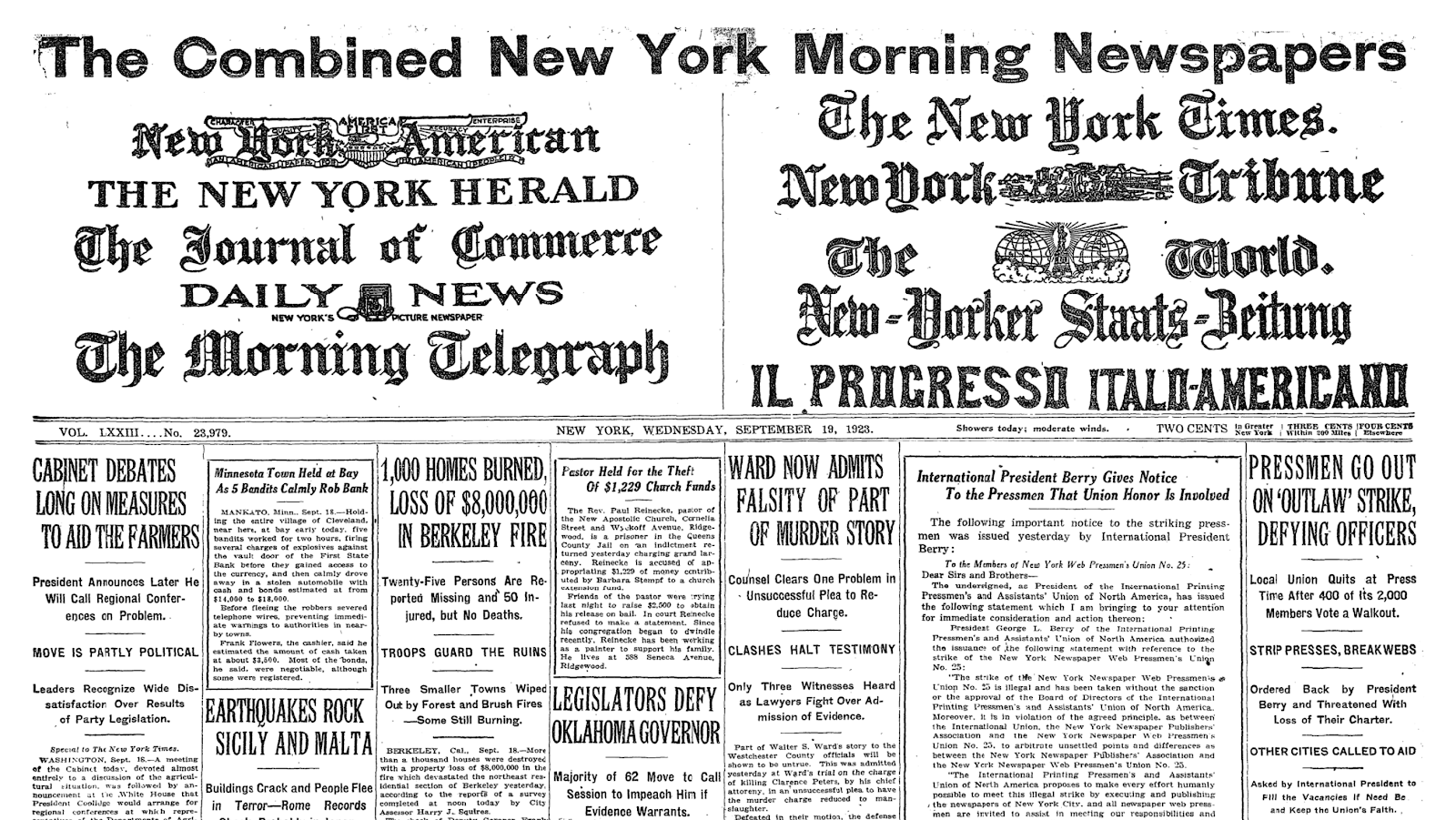 The Combined New York Morning Papers, September 19, 1923. timesmachine.nytimes.com/timesmachine/1923/09/19/issue.html.
The Combined New York Morning Papers, September 19, 1923. timesmachine.nytimes.com/timesmachine/1923/09/19/issue.html. “Wikimedia Commons.” Accessed May 12, 2020. commons.wikimedia.org/wiki/Main_Page.
Wikipedia. “Garden Sharing.” Last modified December 19, 2019. en.wikipedia.org/wiki/Garden_sharing.
Hexamer, Reed. “Mutual Aid Flyer.” Google Drive. Google, March 13, 2020. drive.google.com/open?id=1XfCqfe74KxhtcXm2Mx4mmfAW-aIXRUgF.
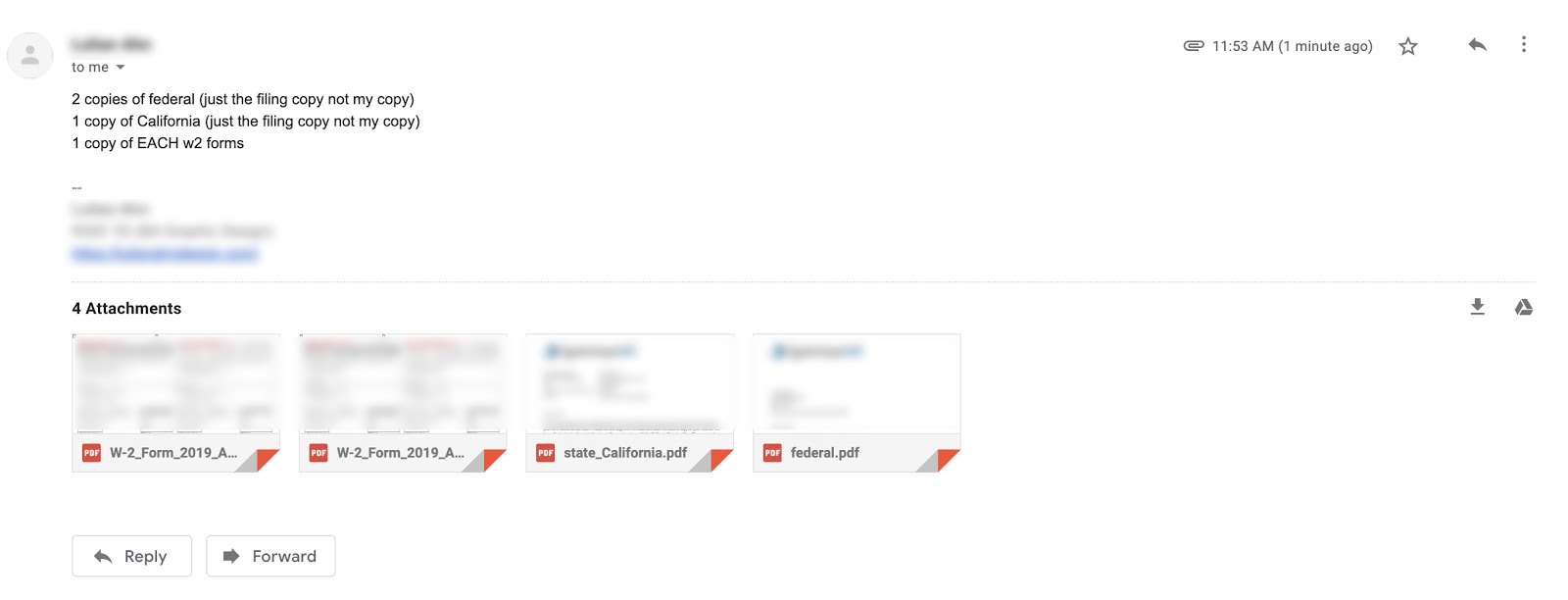 I started offering free printing service after the lockdown; the requests ranged from Amazon return labels to tax documents. Started on April 17, 2020, on-going until public libraries open.
I started offering free printing service after the lockdown; the requests ranged from Amazon return labels to tax documents. Started on April 17, 2020, on-going until public libraries open. Day 10
Balkin, Jeff, and Dan Michaelson. Sometimes it looks like a duck, sometimes it looks like a rabbit: Governance structures in graphic design, decorative form in law, and schools in the public sphere. Other. Yale School of Art, 2012. art.yale.edu/file_columns/0001/0417/balkin.pdf.
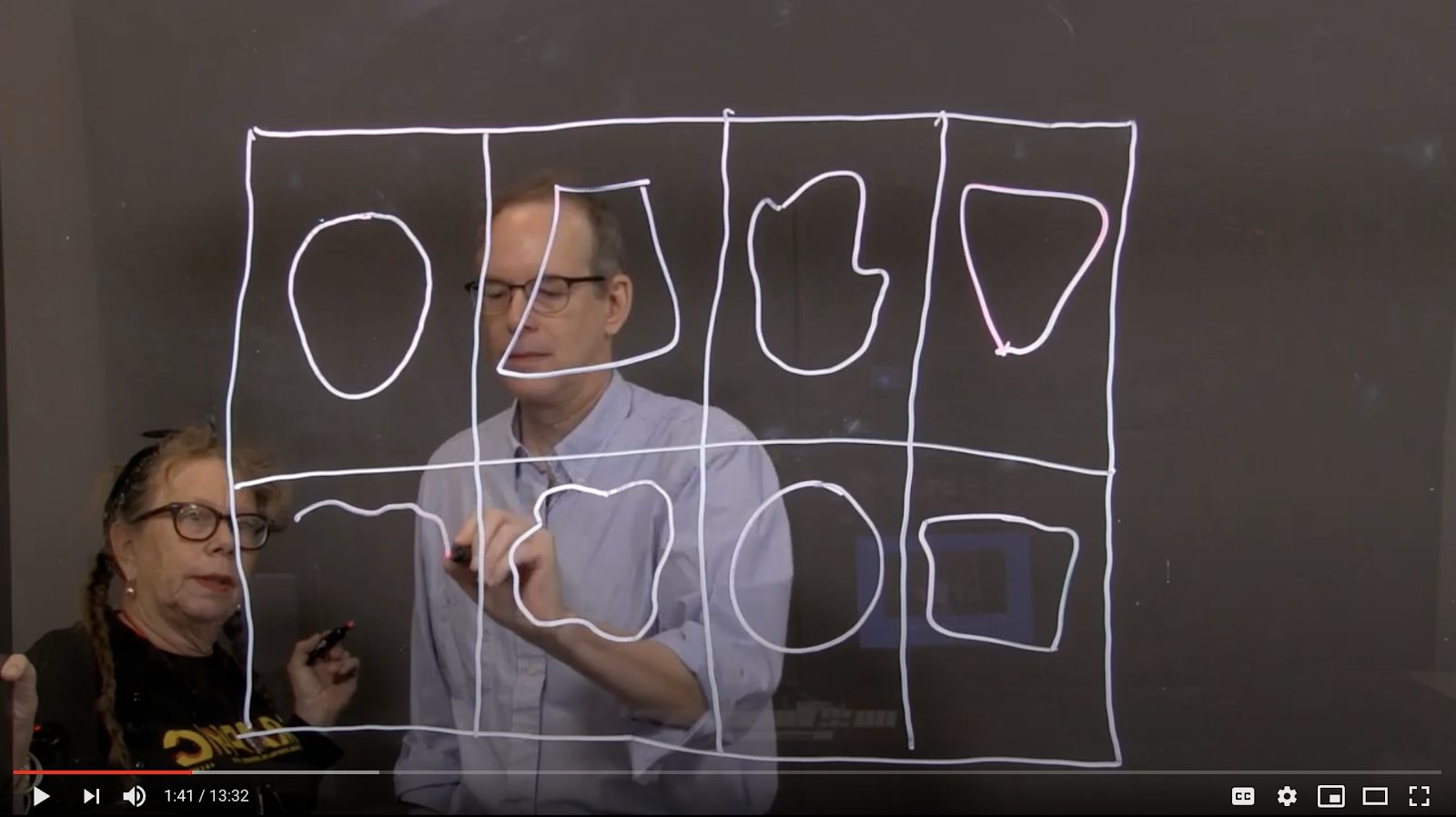 Michael Green's Graphic Medicine Channel. “Drawing Faces Jam With Lynda Barry.” YouTube video, 13:32. December 23, 2017.
Michael Green's Graphic Medicine Channel. “Drawing Faces Jam With Lynda Barry.” YouTube video, 13:32. December 23, 2017.“Neuhaus: Collaborative Worldbuilding.” Studio Moniker, May 19, 2019. neuhaus.world/.
Peeters, Marlies. “Designing in Liquid Times: Generative Graphic Design in an Age of Uncertainty.” Plot(s): Journal of Design Studies 3 (2016). adht.parsons.edu/designstudies/wp-content/uploads/sites/3/2016/08/Interior-Article-2.pdf.
Wikipedia, “Exquisite corpse.” Last modified April 19, 2020. en.wikipedia.org/wiki/Exquisite_corpse.
Day 11
Acatia Finbow, "Suzanne Lacy, Silver Action 2013.” Performance At Tate: Into the Space of Art, Tate Research Publication, 2016. www.tate.org.uk/research/publications/performance-at-tate/case-studies/suzanne-lacy.
“Blank Poster.” Accessed May 12, 2020. blankposter.com/about/.
 OLG 7017. “The Images of Architects edited by Valerio Olgiati.” YouTube video, 3:13, March 25, 2013. www.youtube.com/watch?v=WfCZvRYYyfA.
OLG 7017. “The Images of Architects edited by Valerio Olgiati.” YouTube video, 3:13, March 25, 2013. www.youtube.com/watch?v=WfCZvRYYyfA.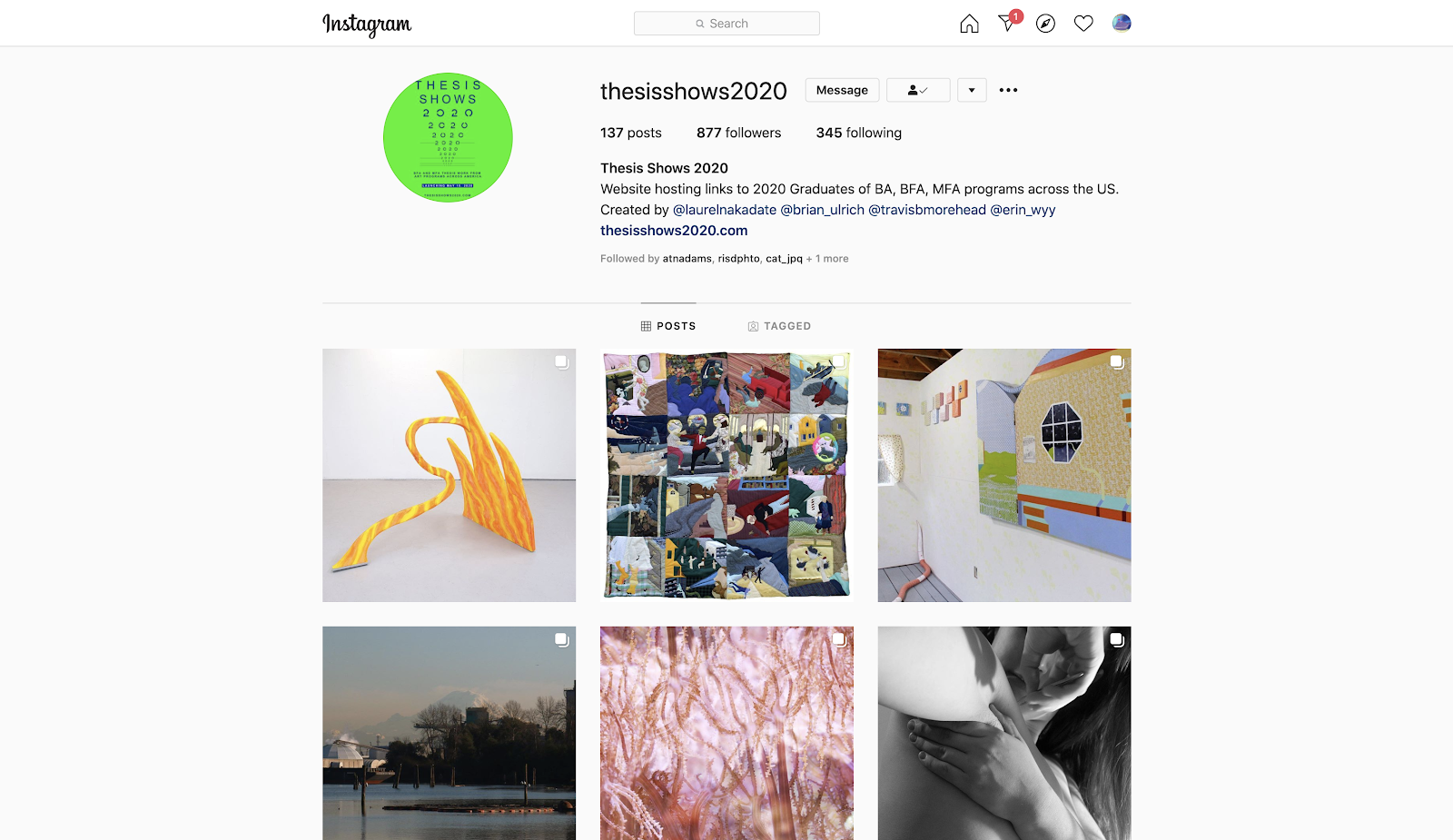 Thesisshows2020. “Thesis Shows 2020.” Instagram. April 1, 2020. www.instagram.com/thesisshows2020/.
Thesisshows2020. “Thesis Shows 2020.” Instagram. April 1, 2020. www.instagram.com/thesisshows2020/.Wikipedia. “One & Other.” Last modified March 6, 2020. en.wikipedia.org/wiki/One_%26_Other.
 A curated list of COVID-19 related resources and projects. Posted on April 21, 2020 near the Community Cupboard on campus.
A curated list of COVID-19 related resources and projects. Posted on April 21, 2020 near the Community Cupboard on campus.Day 12
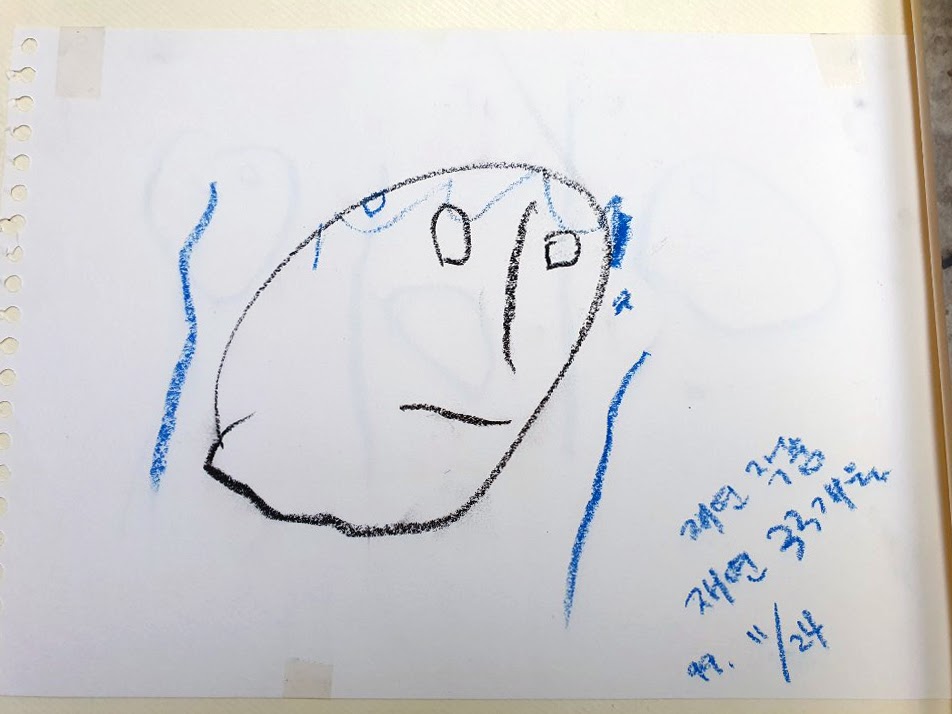 What I consider my first design; the note (written by mom) reads “Jaeyeon’s work of art, 33 months-old.” Made on November 24th, 1999.
What I consider my first design; the note (written by mom) reads “Jaeyeon’s work of art, 33 months-old.” Made on November 24th, 1999. Jackson, Frank. “What Mary Didn't Know.” The Journal of Philosophy 83, no. 5 (1986): 291. doi.org/10.2307/2026143.
Lindgren, Jacob. “Graphic Design's Factory Settings.” Walker Art Center, January 2, 2020. walkerart.org/magazine/jacob-lindgren-graphic-designs-factory-settings.
Day 13
Braidotti, Rosi. “Posthuman, All Too Human.” Theory, Culture & Society 23, no. 7-8 (2006): 197–208. doi.org/10.1177/0263276406069232.
McMorrough, John. "Design for the Apocalypse." Thresholds, no. 35 (2009): 16-19. Accessed May 21, 2020. www.jstor.org/stable/43876561.
 Quito, Anne. “A Legendary Italian Designer Designed His Own Funeral, and He Didn't Miss a Detail.” Quartz. Quartz, May 27, 2016. qz.com/692791/design-legend-massimo-vignellis-last-grand-project-was-his-own-funeral/.
Quito, Anne. “A Legendary Italian Designer Designed His Own Funeral, and He Didn't Miss a Detail.” Quartz. Quartz, May 27, 2016. qz.com/692791/design-legend-massimo-vignellis-last-grand-project-was-his-own-funeral/.Wikipedia. “Svalbard Global Seed Vault.” Last modified April 17, 2020. en.wikipedia.org/wiki/Svalbard_Global_Seed_Vault.
Day 14
Betancourt, Michael. The _______ Manifesto. Print. 1996. www.slideshare.net/MichaelBetancourt7/betancourt-the-manifesto-1996.
Haas, Susan Biali. “COVID-19: It's OK to Feel Overwhelmed and Be Unproductive.” Psychology Today. Sussex Publishers, March 25, 2020. www.psychologytoday.com/us/blog/prescriptions-life/202003/covid-19-it-s-ok-feel-overwhelmed-and-be-unproductive.
Melville, Herman. Bartleby, the Scrivener. Hoboken, NJ: Melville House Pub., 2004.
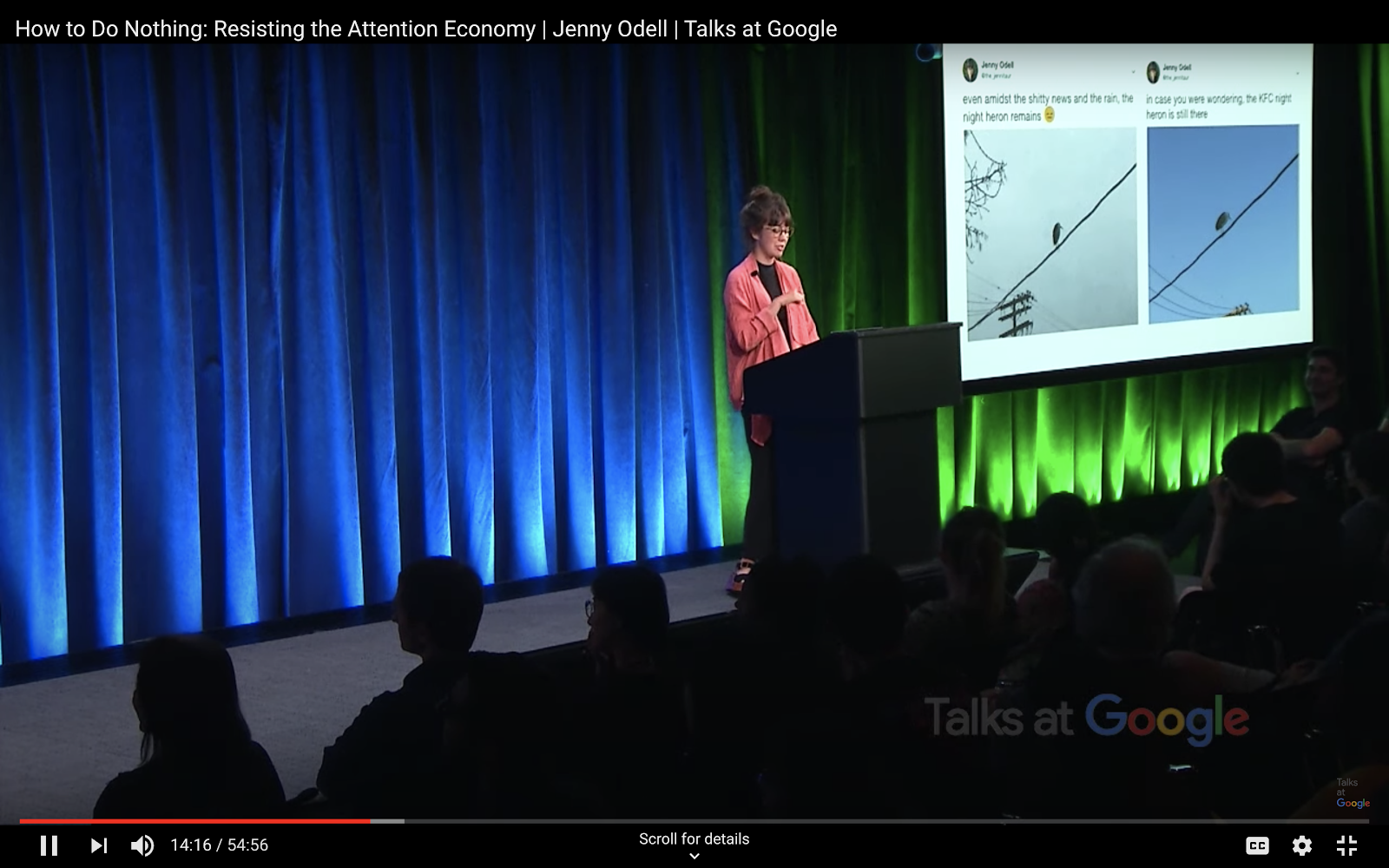 Talks at Google. “How to Do Nothing: Resisting the Attention Economy by Jenny Odell.” YouTube video, 54:56, April 8, 2019. https://www.youtube.com/watch?v=izjlP9qtmBU.
Talks at Google. “How to Do Nothing: Resisting the Attention Economy by Jenny Odell.” YouTube video, 54:56, April 8, 2019. https://www.youtube.com/watch?v=izjlP9qtmBU. Acknowledgement
I would like to thank:
my advisor Ramon Tejada,
my classmates Ben Sampson, G Cha, Gabriel Abascal, Hye Jin Cho, Isobel Connelly, Jack Fahnestock, Pooja Nitturkar, Sara Martinez,
visiting critics Danielle Aubert, Jacqueline Shaw, Kelsey Dusenka, Pouya Ahmadi, Virginia Lee Montgomery,
Meredith Barrett from Center for Arts & Language,
Sue Mazzucco from Graphic Design department,
and those who offered kind words via Zoom, FaceTime, emails, phone calls, and text messages in these crazy, crazy times.
May 22, 2020
Written and designed by Erica Silver under the guidance of Ramon Tejada. This project was made as a thesis in fulfillment of a BFA in Graphic Design from the Rhode Island School of Design.